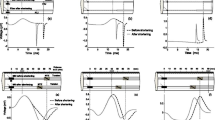Summary
Experiments were performed on an isolated nerve muscle preparation of frog sartorius muscle kept in a solution with reduced calcium ion concentration. The appearance of rhythmic activity of the muscle fibers may be caused by depolarization of either the endplate area or other portions of the membrane. Depolarization resulting in rhythmic activity may be caused by the application of some pharmacological substances (succinylcholine, decamethonium, tetramethylammonium, caffeine, veratrine) or by a nerve impulse. The involvement of the muscle fiber in rhythmic activity is especially effective when the motor nerve is stimulated at a frequency of 10 to 50 stimuli per second.
Similar content being viewed by others
Literature Cited
E. K. Zhukov, Byull. Éksper. Biol. i Med.9, 1, 51 (1940).
P. G. Kostyuk., Biofizika2, 4, 401 (1957).
P. G. Kostyuk, Z. A. Sorokina, and A. I. Shapovalov, Biofizika4, 2, 310 (1959).
D. N. Nasonov, The Local Reaction of Protoplasm and Propagated Excitation [in Russian] (Moscow and Leningrad, 1959).
E. Bülbring, G. Burnstock, and M. E. Holman, J. Physiol.142, 420 (1958).
J. Castillo and B. Katz, Nature171, 1016 (1953).
B. Frankenhaeuser and A. L. Hodgkin, J. Physiol.137, 218 (1957).
G. Ling and R. W. Gerard, J. Cell. Comp. Physiol.34, 397 (1949).
Author information
Authors and Affiliations
Rights and permissions
About this article
Cite this article
Shapovalov, A.I. An intracellular microelectrode study of the mechanism of origin of rhythmic muscle fiber activity. Bull Exp Biol Med 49, 535–538 (1960). https://doi.org/10.1007/BF00782098
Received:
Issue Date:
DOI: https://doi.org/10.1007/BF00782098




